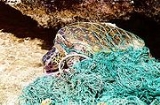
Ghost net
Encyclopedia
.jpg)
Fishing net
A fishing net or fishnet is a net that is used for fishing. Fishing nets are meshes usually formed by knotting a relatively thin thread. Modern nets are usually made of artificial polyamides like nylon, although nets of organic polyamides such as wool or silk thread were common until recently and...
s that have been left or lost in the ocean
Marine debris
Marine debris, also known as marine litter, is human created waste that has deliberately or accidentally become afloat in a lake, sea, ocean or waterway. Oceanic debris tends to accumulate at the centre of gyres and on coastlines, frequently washing aground, when it is known as beach litter or...
by fishermen. These nets, often nearly invisible in the dim light, can be left tangled on a rocky reef or drifting in the open sea. They can entangle fish
Fish
Fish are a paraphyletic group of organisms that consist of all gill-bearing aquatic vertebrate animals that lack limbs with digits. Included in this definition are the living hagfish, lampreys, and cartilaginous and bony fish, as well as various extinct related groups...
, dolphin
Dolphin
Dolphins are marine mammals that are closely related to whales and porpoises. There are almost forty species of dolphin in 17 genera. They vary in size from and , up to and . They are found worldwide, mostly in the shallower seas of the continental shelves, and are carnivores, mostly eating...
s, sea turtle
Sea turtle
Sea turtles are marine reptiles that inhabit all of the world's oceans except the Arctic.-Distribution:...
s, shark
Shark
Sharks are a type of fish with a full cartilaginous skeleton and a highly streamlined body. The earliest known sharks date from more than 420 million years ago....
s, dugong
Dugong
The dugong is a large marine mammal which, together with the manatees, is one of four living species of the order Sirenia. It is the only living representative of the once-diverse family Dugongidae; its closest modern relative, Steller's sea cow , was hunted to extinction in the 18th century...
s, crocodile
Crocodile
A crocodile is any species belonging to the family Crocodylidae . The term can also be used more loosely to include all extant members of the order Crocodilia: i.e...
s, seabird
Seabird
Seabirds are birds that have adapted to life within the marine environment. While seabirds vary greatly in lifestyle, behaviour and physiology, they often exhibit striking convergent evolution, as the same environmental problems and feeding niches have resulted in similar adaptations...
s, crab
Crab
True crabs are decapod crustaceans of the infraorder Brachyura, which typically have a very short projecting "tail" , or where the reduced abdomen is entirely hidden under the thorax...
s, and other creatures, including the occasional human diver. Acting as designed, the nets restrict movement, causing starvation, laceration and infection, and suffocation in those that need to return to the surface to breathe.
Description
Some commercial fisherman use gillnetGillnet
Gillnetting is a common fishing method used by commercial and artisanal fishermen of all the oceans and in some freshwater and estuary areas. The gillnet also is used by fisheries scientists to monitor fish populations. Because gillnets can be so effective their use is closely monitored and...
s. These are suspended in the sea by flotation buoy
Buoy
A buoy is a floating device that can have many different purposes. It can be anchored or allowed to drift. The word, of Old French or Middle Dutch origin, is now most commonly in UK English, although some orthoepists have traditionally prescribed the pronunciation...
s, such as glass float
Glass float
Glass floats, glass fishing floats, or Japanese glass fishing floats are popular collectors’ items. They were once used by fishermen in many parts of the world to keep their fishing nets, as well as longlines or droplines afloat....
s, along one edge. In this way they can form a vertical wall hundreds of metres long, where any fish within a certain size range can be caught. Normally these nets are collected by fisherman and the catch removed. However if this is not done the net can continue to catch fish until the weight of the catch exceeds the buoyancy of the floats. The net then sinks, and the fish are devoured by bottom-dwelling crustaceans and other fish. Then the floats pull the net up again and the cycle continues. Given the high-quality synthetics that are used today, the destruction can continue for a long time.
The problem is not just nets; old-fashioned crab pots, without the required "rot-out panel", also sit on the bottom, where they become self-baiting traps that go on catching crabs year after year. Even balled-up fishing line can be deadly for a variety of creatures, including birds and marine mammals. Over time the nets become more and more tangled. In general, fish are less likely to be trapped in gear that has been down a long time.
The French government offered a reward for ghost nets handed in to local coastguards along sections of the Normandy coast between 1980 and 1981. The project was abandoned when people vandalised nets to claim rewards, without retrieving anything at all from the shoreline or ocean.
See also
- List of environmental issues
- Marine debrisMarine debrisMarine debris, also known as marine litter, is human created waste that has deliberately or accidentally become afloat in a lake, sea, ocean or waterway. Oceanic debris tends to accumulate at the centre of gyres and on coastlines, frequently washing aground, when it is known as beach litter or...
- Drift netting
- Fishing netFishing netA fishing net or fishnet is a net that is used for fishing. Fishing nets are meshes usually formed by knotting a relatively thin thread. Modern nets are usually made of artificial polyamides like nylon, although nets of organic polyamides such as wool or silk thread were common until recently and...

